State Savings Bank Building
| State Savings Bank building | |
|---|---|
Commonwealth_Bank_Sydney-1.jpg) Main façade on Martin Place | |
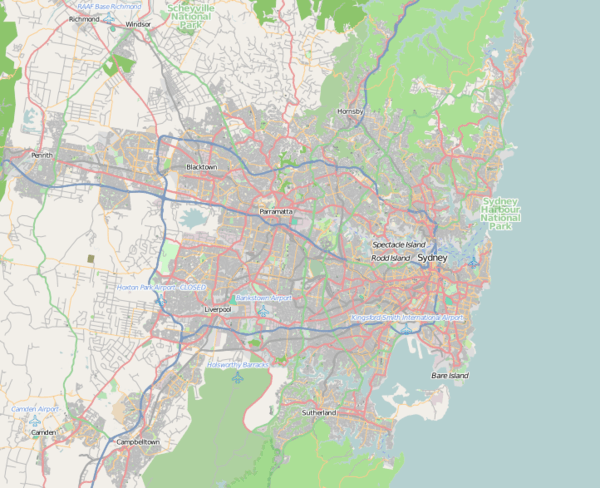 Location in greater metropolitan Sydney | |
| Former names |
|
| Alternative names | Money Box building (although typically refers to the Commonwealth Trading Bank Building)[1] |
| General information | |
| Status | Complete |
| Type | Commercial offices |
| Architectural style | Beaux-Arts |
| Address | 48 Martin Place, Sydney CBD, New South Wales, Australia |
| Coordinates | 33°52′03″S 151°12′37″E / 33.867547°S 151.210155°ECoordinates: 33°52′03″S 151°12′37″E / 33.867547°S 151.210155°E |
| Construction started | 1925 |
| Opened | 1928 |
| Renovated | September 2014 |
| Owner | Macquarie Group |
| Technical details | |
| Floor count | 10 |
| Design and construction | |
| Architecture firm | H E Ross & Rowe |
| Main contractor | Concrete Constructions |
| Designations | Local Government register |
| References | |
| [2] | |
The State Savings Bank Building is a large bank building situated at 48 Martin Place, Sydney, New South Wales, Australia. It was built in 1928 after designs by Ross and Rowe. After several decades of use by the Commonwealth Bank of Australia, including as its headquarters from 1984, it was purchased by financial services company Macquarie Group in 2012, refurbished, and now serves as Macquarie's global headquarters as 50 Martin Place.[3]
Description and history
The building was originally constructed as the headquarters of the Government Savings Bank of New South Wales. It was subsequently owned by the Commonwealth Bank of Australia. It has a distinctive terracotta and pink granite façade in the Beaux-Arts architectural style. The interior features large scagliola columns, extensive use of marble, and a plaster and pressed metal ceiling. The exterior features four massive Ionic columns and detail in pink glazed ceramic tiles. The building's square trading hall was originally one of the largest in the world. A stately vault is housed in the basement.[2]
The main portal, opening onto Martin Place, features a unique bronze door which descends into the floor when opened. The building has been described as "a masterpiece of civic scale and precise detail."[4] The building was listed on the now defunct Register of the National Estate between 1978 until the register's abolition in 2007;[5][6] however it is now listed on the City of Sydney local government heritage register.[2]
The building was purchased by Australian financial services company Macquarie Group in March 2012 along with an adjoining building, with suggestions that the State Savings Bank building itself might be refurbished and on-sold.[7] Instead, Macquarie refurbished the building and it now serves as the company's global headquarters. In the ground floor banking hall, Macquarie installed two circular glass lifts with the lift shaft penetrating the ceiling. A widened atrium penetrates the office floors above, and the roof has been renovated with the addition of a large glass elliptical dome.[3]
Money boxes
After its purchase by the Commonwealth Bank in 1931, the image of the building was sometimes used on money boxes issued by the Commonwealth Bank to children. The money boxes were rectangular shape, roughly reflecting the dimensions of the bank building, and printed with the building's exterior. As a result, it is sometimes referred to as the "money box building" (although more often that nickname refers to the Commonwealth Trading Bank Building, on the corner of Pitt Street and Martin Place, which had been depicted on money boxes since 1922 and remained the image on the majority of money boxes).[1]
Gallery
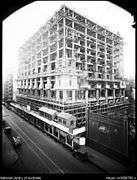 The State Savings Bank building during construction.
The State Savings Bank building during construction.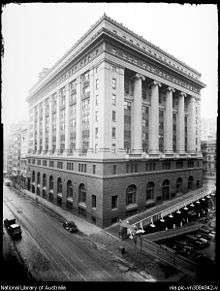 The State Savings Bank building on completion.
The State Savings Bank building on completion.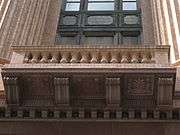
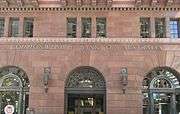 Exterior detail and signage
Exterior detail and signage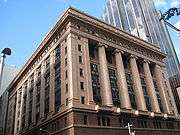 The State Savings Bank building viewed from Castlereagh Street
The State Savings Bank building viewed from Castlereagh Street
See also
References
- 1 2 McNeilage, Amy (26 September 2012). "A telling tale of two tin moneyboxes". The Sydney Morning Herald. Retrieved 21 May 2018.
- 1 2 3 "Commonwealth Bank of Australia including interior". New South Wales State Heritage Register. Office of Environment and Heritage. Retrieved 21 May 2018.
- 1 2 "Innovation drives new global HQ design". Macquarie Group. 7 February 2015. Retrieved 21 May 2018.
- ↑ Apperly (1994). A Pictorial Guide to Identifying Australian Architecture. Angus and Robertson. p. 162.
- ↑ "Commonwealth Bank, 48-50 Martin Pl, Sydney, NSW, Australia (Place ID 1838)". Australian Heritage Database. Department of the Environment. Retrieved 21 May 2018.
- ↑ The Heritage of Australia. Macmillan Company. 1981. p. 2.
- ↑ "Macquarie Group buys building from Commonwealth Bank". The Australian. 29 March 2012.
Further reading
- Kerr, James Semple (1989). Elephant castle: an investigation of the significance of the head office building of the Commonwealth Banking Corporation of Australia, Sydney. Sydney: National Trust of Australia (New South Wales). ISBN 0947137173.
External links
| Wikimedia Commons has media related to State Savings Bank building. |
| Wikimedia Commons has media related to Beaux-Arts architecture in Australia. |